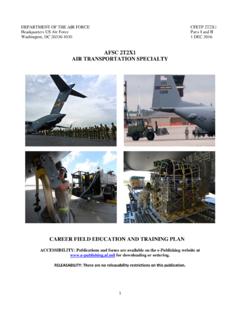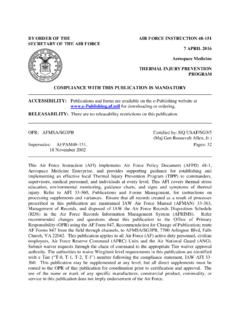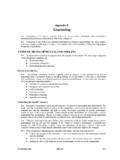Transcription of Channel Duty Guidance - NCALT
1 Channel duty Guidance Protecting vulnerable people from being drawn into terrorismStatutory Guidance for Channel panel members and partners of local panels Crown Copyright 2015 The text in this document (excluding the Royal Arms and other departmental or agency logos) may be reproduced free of charge in any format or medium providing it is reproduced accurately and not used in a misleading context. The material must be acknowledged as Crown copyright and the title of the document specified. Where we have identified any third party copyright material you will need to obtain permission from the copyright holders : 978-1-78246-796-01 ContentsContentsStatus and scope of the duty 3 Channel Panels & Panel 4 Requirements for Panel PartnersChannel & Children s Social ServicesCombined PanelsChannel Panel 5 The Channel Police PractitionerThe Local Authority ChairPanel PartnersThe Channel 6 Identifying Vulnerable Individuals The Referral stageScreening & information gathering stageCo-operation by partners of a panelConsent prior to information sharing Vulnerability Assessment Framework Channel & Offender ManagementThe Channel 7 Requirement to establish a Channel Panel Panel MeetingsSupport Plans Consent prior
2 To supportSupport to address identified vulnerabilities Funding support plansMonitoring Channel supportReferral to alternative forms of supportReviewing Channel CasesSharing Good 8 Information 9 Freedom of Information requestsSubject Access RequestsEnquiriesAnnex A Sharing Information with PartnersAnnex B Partners required to cooperate with Local Panels (Schedule 7 Partners of local panels)Annex C Vulnerability Assessment Framework Annex D Other useful Guidance 2 Channel GuidanceGuidance for members of a panel and partners of local panels in England and Wales on the duty in the Counter-Terrorism and Security Act 2015 to provide support for people vulnerable to being drawn into terrorism.
3 1. This Guidance has been issued under sections 36(7) and 38(6) of the Counter-Terrorism and Security Act 2015 (the CT&S Act) to support panel members and partners of local panels. 2. Sections 36 to 41 of the CT&S Act 2015 sets out the duty on local authorities and partners of local panels to provide support for people vulnerable to being drawn into terrorism. In England and Wales this duty is the Channel programme. For the purpose of this Guidance , the term Channel or Channel programme refers to the duty to as set out in the CT&S Act 2015. 3. This Guidance is specifically aimed at members and partners of local panels involved in the Channel process.
4 The list of partners of local panels subject to the provision can be found in Schedule 7 of the CT&S Act (also replicated in within Annex B of this Guidance ). The Channel Police Practitioner and the Local Authority Chair are key participants in the Channel process; developing a strong working relationship between partners is vital to the success of Channel . 4. The purpose of this document is to: a. provide Guidance for Channel panels;b. provide Guidance for panel partners on Channel delivery (that is, those authorities listed in Schedule 7 to the CT&S Act who are required to co-operate with Channel panels and the police in the carrying out of their respective functions in Chapter 2 of Part 5 of the CT&S Act the list is also replicated in Annex B of this Guidance );c.
5 Explain why people may be vulnerable to being drawn into terrorism and describe indicators which may suggest so; andd. provide Guidance on the support that can be provided to safeguard those at risk of being drawn into terrorism. Status and Scope of the DutyChannel duty guidance3 Channel Guidance1. The Prevent strategy 1, published by the Government in 2011, is part of our overall counter-terrorism strategy, CONTEST. The aim of the Prevent strategy is to reduce the threat to the UK from terrorism by stopping people becoming terrorists or supporting The Prevent strategy addresses all forms of terrorism and we continue to prioritise according to the threat they pose to our national security; the allocation of resources will be proportionate to the threats we face.
6 The most significant of these threats is currently from terrorist organisations in Syria and Iraq, and Al Qa ida associated groups. But terrorists associated with the extreme right also pose a continued threat to our safety and The Prevent strategy has three specific strategic objectives: respond to the ideological challenge of terrorism and the threat we face from those who promote it; prevent people from being drawn into terrorism and ensure that they are given appropriate advice and support; and work with sectors and institutions where there are risks of radicalisation that we need to The Government remains absolutely committed to protecting freedom of speech in England and Wales.
7 But preventing terrorism will mean challenging extremist (and non-violent) ideas that are also part of a terrorist ideology. Prevent will also mean intervening to stop people moving from extremist groups or from extremism into terrorist-related We define extremism as vocal or active opposition to fundamental British values, including democracy, the rule of law, individual liberty and mutual respect and tolerance of different faiths and beliefs. We also include in 1 definition of extremism calls for death of members of our armed forces, whether in this country or Section 26 of the CT&S Act 2015 places a duty on certain bodies in the exercise of their functions to have due regard to the need to prevent people from being drawn into terrorism.
8 Separate Guidance has been issued on the Prevent duty2. 7. Channel forms a key part of the Prevent strategy. The process is a multi-agency approach to identify and provide support to individuals who are at risk of being drawn into terrorism. 2 1: Prevent4 Channel Guidance8. Safeguarding and promoting the welfare of children, young people and adults is everyone s responsibility. Local authorities have a statutory duty to safeguard children, young people and adults in relation to their social services functions. Section 11 of the Children Act 2004 places duties on a range of organisations and individuals3 to ensure their functions (including any that are contracted out) to have regard to the need to safeguard and promote the welfare of children.
9 9. In England, the Working Together to Safeguard Children4 is relevant; it sets out the legislative requirements and expectations in individual services to safeguard and promote the welfare of children. In Wales, the Keeping learners safe5 Guidance should be referred to which includes advice on radicalisation. All local authorities in England and Wales are required to have Local Safeguarding Children Boards for their area with an equivalent strategic leadership role in relation to partners involved in safeguarding children Safeguarding adults is also a key role for local authorities. Under the Care Act 20146, from April 2015 local authorities are required to have Safeguarding Adults Boards7 in their area.
10 These boards provide strategic leadership to the work 3 Local authorities (including children s and adult social care services), NHS organisations, the police, the Probation Service,Governors/Directors of Prisons and Young Offender Institutions, Directors of Secure Training Centres, Youth Offending Teams. Analogous provision is made in relation to Wales in section 28 of the 2004 Working together to Safeguard Children: Safeguarding children: Working together under the Children Act 2004 information for Wales has been supplemented in: which includes advice on Care Act 2014: Adult Safeguarding Factsheet: #factsheet-7-protecting-adults-from-abus e-or-neglectof the local authority, and partner agencies, on the development of policy and practice in relation to safeguarding adults at risk.






